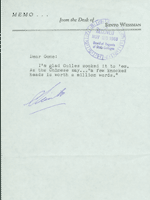| Don Jorgenson, Jon Guiles, John Schuh, Jack Steinhilber, and Sandra McCreary describe the disciplinary hearings. - 1.2MB mp3 |
Please click a thumbnail for more detail.

Winnebago County Court Judge James V. Sitter, a jurist whose use of racially insensitive language raised suspicions of partiality. By March 1969, the students’ attorneys had successfully transferred their civil trials from Sitter’s courtroom to circuit court and negotiated a “no contest” plea (and a $125 fine) for unlawful assembly.
Photo courtesy of The Paper of Central Wisconsin.

Interested faculty members and involved parents appeal to President Guiles in efforts to reinstate students involved in the recent demonstration.
Photo by Mike Tomczyk courtesy of The Paper of Central Wisconsin.

J. Ward Rector, the hearing agent chosen by the WSU regents to preside over the suspension hearings of the “Oshkosh 94.” A former Associate Justice for the Wisconsin Supreme Court, Rector had recently retired as Vice President and General Counsel of the First Milwaukee Trust Co.
Photo courtesy of The Paper of Central Wisconsin.

University officials were inundated by citizens' appeals regarding the Black Thursday demonstrations. By a large margin, correspondents excoriated the students and demanded restitution for the public property destroyed during the brief spasm of vandalism.
Two central questions concerning the treatment of the black student demonstrators emerged in the early phases of their civil trial (conducted at the Winnebago County Courthouse) and the campus disciplinary hearings: would the students be prosecuted as a group or as individuals, and, in the face of bitter public enmity, how would students’ procedural rights be protected? Milwaukee civil rights attorney Lloyd Barbee, representing a great majority of those arrested, insisted that the black student defendants—all of whom faced the possibility of two-year prison terms—receive individual trials, even though this would place a great strain on the county court’s caseload.
A similar plea to the WSU administration and Board of Regents was rejected, thus triggering a long and complicated legal battle that ended up in the U.S. District courtroom of Judge James E. Doyle, the father of our current governor. On December 6 Doyle ruled that WSU Oshkosh had to hold a hearing by December 20 in order to determine the students’ futures at the university.
In a span of three days, a hearing was conducted at the Winnebago County Courthouse in Oshkosh. Few people were satisfied at the hurried pace of the proceedings. Worse yet, only one of the Oshkosh 94—Willie Sinclair—was able to testify about his involvement in the demonstration. In the end, neither the testimony of Sinclair, the protestations of the students’ attorneys, the presentation of facts, nor the sanctity of due process itself were any match for the Board of Regents’ determination to punish the Oshkosh 94.
On December 20 Regent W. Roy Kopp of Platteville delivered the board’s unanimous decision to expel ninety of the Oshkosh 94. (Four other students were only suspended since their attorneys were able to prove that they were not in Dempsey Hall when the damage occurred on the morning of November 21.)
